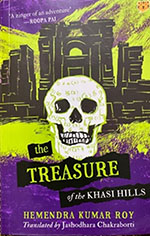When seventeen-year-old Kumar throws a skull found in his grandfather’s trunk out of the window into a ditch, he very nearly misses the whole adventure of a search for lost treasure. Kumar begins to realize that this is no ordinary skull when the same night a burglary takes place in his house in Kolkata. It is then that he consults his older and wiser friend Bimal and together they begin to unravel the mystery of the skull with its curious markings and its link to the message written in his grandfather’s notebook. A second burglary convinces them that no time is to be lost. Bimal and his devoted attendant, Ramhari along with Kumar and his ever-faithful dog Bagh embark on a journey which takes them from the safety of Kolkata across the magical Padma River to the grandeur and perils of the Khasi Hills. It is only the friendship and loyalty between the four adventurers that help them to overcome all obstacles.
These scenes take place in the opening chapters of The Treasure of the Khasi Hills, a story written by the renowned Bengali author, Hemendra Kumar Roy. It was first published in 1930 as Jawkher Dhawn meaning ‘The Yaksha’s Treasure’.Jashodhara Chakraborti’s translation makes this the first children’s book by Roy to be made accessible beyond a Bengali readership. She was immersed in Bengali children’s literature from childhood and remembers herself as a young girl being enthralled by this particular book; her excitement remains as she ably captures the flavour and texture of the story in English.
The fast-moving narrative is gripping for any reader but is particularly geared to young readers 10 years and above. The tale is set against the beauty of the Khasi Hills and its caves and the hovering presence of the ghosts and spirits who reportedly live there. Kumar is the narrator and describes not only their skirmishes with near disaster but his own feelings at times of fear and despair.
‘Danger makes me happy,’ boldly declares Bimal to his more timorous friend Kumar just as they set out. But even Bimal has no idea just how perilous their adventure would prove. The story is packed with cliff-hanging suspense from beginning to end. Their journey is made more terrifying by the ruthless pursuit of the greedy Karali, a treacherous former friend of Kumar’s grandfather, who will stop at nothing to grab the treasure for himself.
A ghastly ghost story at the cremation grounds adds to Kumar’s sense of dread so that even the cry of young cranes seems to him like the dreadful wailing of babies. Nightmare and reality are blurred as they are trapped in a maze of pathways below ground and hear spine chilling ‘horrible metallic laughter’.
Although the book was written nearly a hundred years ago, the pace and the dramatic tension of the book hardly falters for the modern reader. The context of pre-Independence India and life in Calcutta in the times of the Raj is evocatively described. There is an undercurrent of nationalist fervour and Bimal is undeniably a fearless hero prepared to meet the challenge of any bully or adversary—familiar or alien. Bimal, in the tradition of a Sherlock Holmes, relies on his intellect and power of logic even in the face of seemingly supernatural happenings.
In one way, the book is dated by its portrayal of the manservant Ramhari who is expected to sleep outside with the dog until Bimal realizes he depends on his protection inside the room! But finally, it is Ramhari who shows the greatest wisdom about what is truly valuable in life.
There is also a marked absence of female figures and the frequent references to male prowess makes one feel uncomfortable. However, in the present context where middle-class children, including teenagers, are rarely allowed far out of sight from adult supervision, it is refreshing to read of an earlier time when youth were encouraged to be more independent and resourceful. The ingenuity and skill of Bimal confronts every kind of challenge from combating marauding tigers and vicious thugs to making a bridge across a gaping gorge and lighting a fire from the resin of pinewood.
The ending is not what the reader might have expected but there is a resolution that is more satisfying than a more conventional ‘happy ending’.
This is only one of thirty stories that have been written about Bimal and Kumar’s adventures. It is to be hoped that others will also be made available for a wider audience.
November 2023, volume 47, No 11

